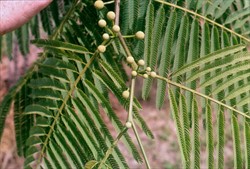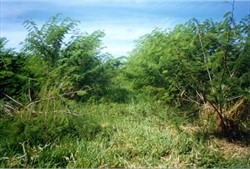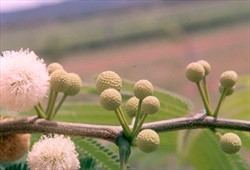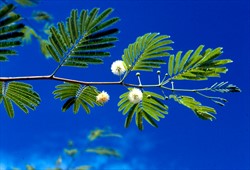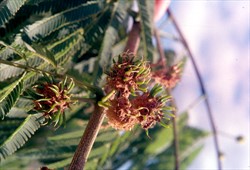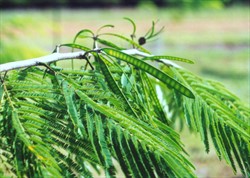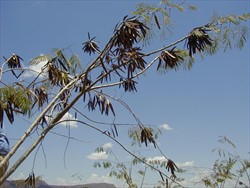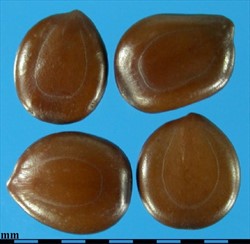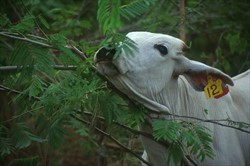Leucaena collinsii
Tropical Forages
Leucaena collinsii Britton & Rose
Subordinate taxa
Leucaena collinsii Britton & Rose subsp. collinsii
Leucaena collinsii Britton & Rose subsp. zacapana C.E. Hughes
None listed in GRIN.
Family: Fabaceae (alt. Leguminosae) subfamily: Caesalpinioideae (mimosoid clade*) tribe: Mimoseae.
* Azani, N. et al. [97 authors from 54 institutions] 2017. A new subfamily classification of the Leguminosae based on a taxonomically comprehensive phylogeny. Taxon 66: 44–77.
Deciduous tree (4‒) 10‒15 (‒20) m tall; bark grey brown with shallow rusty orange brown vertical fissures. Leaves paribipinnate with (5‒) 6‒16 pairs of pinnae; rachis 4‒9 cm long, 25‒56 pairs of pinnules; pinnules 4‒7 mm long, 1‒2 mm wide, asymmetric about mid vein, broadly linear. Petiole gland green, sessile, dome-shaped (2 × 1 mm) with a narrow central pore, inserted below lower pair of pinnae. Capitulum (flower head) 9‒24 mm in diameter with 55‒170 pale cream-white flowers in groups of 2‒3 (‒6) in leaf axils of actively growing shoots. Leaves develop with flower heads, the flowering shoot indeterminate in growth with pods borne on older wood within crown. Pod 11‒18 (‒20) cm × (0.7‒) 1.0‒1.9 cm, pendant, glabrous, mid-brown, opening along both sutures at maturity. Seeds mid-brown, 9‒20 per pod, 6.5‒8.8 mm long.
ssp. collinsii: Tree with open crown and heavy branching. Leaves ≥14 cm long with ≥7 pairs of pinnae and ≥45 pairs of leaflets per pinna, capitula ≥15 mm in diameter at anthesis with ≥140 flowers per capitulum, pods >16 cm long and ≥17mm wide. 22,000‒23,000 seeds per kg.
ssp. zacapana: Heavily branched when young. Leaves ≤12 cm long with ≤8 pairs of pinnae and ≤40 pairs of leaflets per pinna, capitula ≤16 mm in diameter at anthesis with ≤85 flowers per capitulum, pods ≤13.5 cm long and ≤12 mm wide. 30,000‒36,000 seeds per kg.
Similar species
L. collinsii: petiolar gland convex, flowers cream-white.
L. trichandra: petiolar gland concave (crateriform), flowers pink.
English: typical Collins lead tree (ssp. collinsii); Zacapa Collins lead tree (ssp. zacapana)
French: leucéna de Collins typique (ssp. collinsii); leucéna de Collins de Zacapa (ssp. zacapana)
Latin America: chalip, chilíp, guash, guash de monte (Huehuetenango, Guatemala); guaje, yaje (Zona Oriental, Guatemala); guaje chapín (Esquintla, Guatemala); chijlip (Mexico)
ssp. collinsii
Native:
Northern America: Mexico (Chiapas)
Central America: Guatemala (Huehuetenango)
ssp. zacapana
Native:
Central America: Guatemala (s.e.)
Forage
L. collinsii has been used experimentally as directly grazed forage grown in hedgerows in Papua New Guinea, humid-tropical Australia and the Philippines or as cut-and-carry forage in Vietnam and the Philippines. Neither subspecies has been planted commercially in exotic locations.
Environment
It is a nitrogen fixing tree and lopped leaves and twigs are applied as green manure. The tree can be intercropped in a taungya system (a particular agroforestry system where annual crops are grown in association with tree species until the trees become more mature) or in rotation with fruit trees where L. collinsii provides both livestock feed and green manure.
Other
The immature pods of ssp. collinsii are collected and sold into markets of nearby cities in regions in which it is native. The seeds are used for human consumption. Both subspecies produce high quality firewood. Natural stands of subsp. zacapana are managed for fuelwood and pole production for construction of houses and fences. The tree stem exudes a gum that is similar to gum arabic in properties. Trees of ssp. collinsii are planted at field boundaries and around houses as a living fence.
Soil requirements
In the native range, grows on highly variable soils from self-mulching vertisols to shallow limestone-derived soils. Generally found on alkaline soils pH 7.0‒8.5, but will grow in soils with pH (H2O) above 5.5, or above 5.0 where aluminium saturation is very low. Neither is adapted to soils with low pH, low P, low Ca, high aluminium saturation and high salinity.
Moisture
Native to sub-humid areas with (500‒) 900‒1,200 mm annual rainfall and a severe dry season of 5‒7 months. Trees are completely deciduous, losing all their leaves at the height of the dry season. Both subspecies are intolerant of waterlogging and must be grown in well-drained soils. While both are very drought tolerant, ssp. collinsii is most productive in humid-tropical environments with only short dry seasons. Ssp. zacapana grows in considerably drier environments than subsp. collinsii (semiarid, with 500‒700 mm per year and a long dry season up to 7 months) .
Temperature
Average annual temperature of 22‒25 ºC in the native range. Requires temperatures of 22‒30 ºC for optimum growth. Growth ceases at 16‒17 ºC. Light frosts will kill leaf. Very heavy frosts will kill stems back to ground level but will not kill mature trees.
Light
Normally grown in full sun. Responses to shade unknown.
Reproductive development
Flowers in the early dry season into shortening days. Pods ripen 6‒7 months later in the early wet season.
Defoliation
Tolerant of repeated, heavy defoliation in cutting and grazing trials and under severe grazing in the native range. Branches strongly following removal of apical dominance.
Fire
Mature plants are tolerant of fire, regrowing readily from burnt stumps. Fires are common in the native range.
Guidelines for establishment and management of sown forages.
Establishment
Relatively slow to establish, particularly in competition with weed species. For best results plant on deep, well drained soils with a pH above 5.5 and maintain a weed-free area of at least 2 m around establishing plants. Seed must be scarified to break the testa. Mechanical scarification, using coarse sandpaper (for small seed lots) or abrasive lined rotating drum scarifiers, is preferred to hot water treatment. Specific rhizobium is required (e.g. CB 3060, TAL1145, LDK4).
Small areas can be planted by either seed or seedlings. Seedlings are normally raised in poly bags for plug planting at 4‒5 months old. Seedlings can also be raised in beds and removed for planting as bare-rooted seedlings if 'topped and tailed'.
Fertilizer
Normally not fertilized under rain-grown conditions. Starter N and P may be used when establishing into depleted soils on cropping lands.
Compatibility (with other species)
Will combine well with a range of tropical grasses provided that grass and weed competition is controlled during establishment.
Companion species
Grasses: Planted successfully in hedgerows into signal grass (Urochloa decumbens ) in Papua New Guinea, but failed to establish well into Imperata cylindrica in the Philippines due to inadequate grass control during establishment.
Pests and diseases
Ssp. collinsii is highly resistant to the leucaena psyllid (Heteropsylla cubana Hemiptera: Psyllidae), with various mechanisms to discourage the insect. Psyllid-susceptibility varies in ssp. zacapana depending on genotype. The soft scale (Cocus longulus Hemiptera: Coccidae) attacks the tall stems causing a reduction in productivity. The associated sooty mould that develops on the sugary exudates from the scale can cover the stems and temporarily kill under-storey grasses. Soft scale is generally an infrequent pest, with populations rarely building to cause economic damage. Soil insects such as earwigs, scarab beetles, termites and cut worms can cause serious damage to emerging seedlings and should be controlled using insecticide baits. Seed production can be reduced by the flower-eating larvae of the moth Ithome lassula (Lepidoptera: Cosmopterigidae), and by three species of seed-eating bruchid beetles of the genus, Acanthoscelides (Coleoptera: Chrysomelidae: Bruchinae): Acanthoscelides macrophthalmus infests both subspecies, while A. mankinsii infests seed of ssp. collinsii and A. boneti infests seed of ssp. zacapana. Spur-throated locusts (Austracris guttulosa Orthoptera: Acrididae) occasionally attack L. collinsii, defoliating mature plants and killing seedlings during early establishment.
A range of pathogenic fungi and other insects occasionally attack L. collinsii. Damping-off diseases caused by the fungal species, Pythium or Rhizoctonia commonly kill newly emerged nursery and field-grown seedlings.
Ability to spread
Very unlikely to spread under grazing or regular cutting.
Weed potential
Lower weed risk cf. L. leucocephala due to lower levels of seed production and long maturation time of pods, but is none-the-less considered to possess weed potential due to its precocity and moderate levels of seed production. Has potential to colonise open disturbed habitats.
Nutritive value
One of the highest quality Leucaena spp. for ruminant production, L. collinsii subsp. collinsii has IVDMD of 68‒70%, negligible concentrations of condensed tannins (c. 0.1% of DM), and low concentrations of mimosine (<2%).
Palatability/acceptability
Highly palatable to a wide range of ruminants, mongastrics and invertebrates. Slightly less palatable to ruminants in comparison with L. leucocephala, based on short term grazing and cafeteria trials.
Toxicity
Contains low concentrations of mimosine compared with L. leucocephala (<2%), but mimosine will still limit its inclusion in the diet of monogastrics to <15% of DM. Contains only trace concentrations of condensed tannins.
Dry matter
Most productive in humid tropical climates (>1,200 mm annual rainfall) with short or no dry season. May be slower to establish than L. leucocephala, but of similar subsequent productivity in humid-tropical environments, particularly where the psyllid is problematic. Considerably less productive in sub-humid and cool climates.
Animal production
Supported steer gains of 0.58 kg/hd/day in combination with signal grass (Urochloa decumbens) in Papua New Guinea, compared with 0.3 kg/hd/day for the signal grass control. Supported steer gains of 0.35 kg/hd/day in combination with Imperata cylindrica in the Philippines, compared with 0.14 kg/hd/day for the I. cylindrica grass control.
L. collinsii subsp. collinsii is a self-incompatible diploid (2n = 52, 56). Hybridizes readily with some diploid species, L. macrophylla, L. lanceolata, L. trichandra, L. pulverulenta and L. shannonii, but relatively poorly with the tetraploid and other diploid species of Leucaena. Ssp. collinsii is native to a contiguous, restricted region and apparently contains little genetic variability. L. collinsii is one of the most psyllid resistant leucaena species and has been used in breeding programmes to improve resistance of other species.
Seeds over a 2-month period in the early wet season in the native range. Seed-fill occurs late in the fruiting cycle and green pods may initially appear to be without seed. In Australia, seed production has been made difficult by the long period of pod maturity during which it is susceptible to seed-eating bruchid beetles. Seed production potential appears to be modest (<100 kg/ha).
Can be controlled by basal bark application of herbicides containing 120 g/L picloram and 240 g/L triclopyr mixed with diesel.
Application of glyphosate to regrowth following slashing will kill trees, although repeat applications may be necessary.
- Very high nutritive value.
- Highly resistant to psyllids.
- Low condensed tannin and mimosine concentrations.
- Persistent under grazing and cutting once established.
- Slow to establish.
- Lower growth potential cf. L. leucocephala, except in high psyllid environments.
- Poor growth in sub-humid environments.
https://www.agric.wa.gov.au/sites/gateway/files/Hughes%2C%20Colin%20-%20Leucaena-species%20diversity%20and%20genetic%20resources.pdf (Leucaena: species diversity & genetic resources)
Galgal, K.K., Shelton, H.M., Mullen, B.F. and Gutteridge, R.C. (2006) Animal production potential of some new Leucaena accessions in the Markham valley, Papua New Guinea. Tropical Grasslands 40:70–78. bit.ly/3dHYs99
Hughes, C.E. (1998) Leucaena, A genetic resources handbook. Oxford University Press, Oxford, UK. bit.ly/2Iw31af
Shelton, H.M., Gutteridge, R.C., Mullen, B.F. and Bray, R.A. (eds). (1998) Leucaena - adaptation, quality and farming systems. Proceedings of a Workshop Held in Hanoi, Vietnam, 9–14 February 1998. ACIAR Proceedings No. 86. Australian Centre for International Agricultural Research (ACIAR), Canberra, Australia. purl.umn.edu/135197
Note: Detailed updates on knowledge relating to Leucaena were provided in papers presented at the International Leucaena Conference held at The University of Queensland, Brisbane, Australia, 1‒3 November 2018. All papers were published under a publication agreement with the Organizing Committee in two Special Issues of Tropical Grasslands-Forrajes Tropicales: ILC2018 No. 1 - May 2019 Vol 7, No 2. 24 papers presented during Sessions 1‒4 of the Conference. http://www.tropicalgrasslands.info/index.php/tgft/issue/view/29/showToc and ILC2018 No. 2 - September 2019 Vol 7, No 4. 36 papers presented during Sessions 5‒8 of the Conference. http://www.tropicalgrasslands.info/index.php/tgft/issue/view/31/showToc.
None released.
OFI 51/88, OFI 52/88 Selected by Oxford Forestry Institute, United Kingdom. Originate from the Chiapas depression in southern Mexico and western Guatemala. Little variation was found between, or within accessions, in agronomic trials.
K450, K461 and several others Selected in Hawaii, USA. Originate from the Chiapas depression in southern Mexico and western Guatemala.
